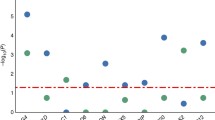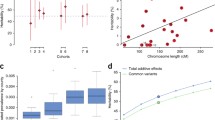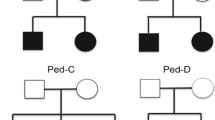Abstract
We describe a pedigree of 71 individuals from the Republic of Cameroon in which at least 33 individuals have a clinical diagnosis of persistent stuttering. The high concentration of stuttering individuals suggests that the pedigree either contains a single highly penetrant gene variant or that assortative mating led to multiple stuttering-associated variants being transmitted in different parts of the pedigree. No single locus displayed significant linkage to stuttering in initial genome-wide scans with microsatellite and SNP markers. By dividing the pedigree into five subpedigrees, we found evidence for linkage to previously reported loci on 3q and 15q, and to novel loci on 2p, 3p, 14q, and a different region of 15q. Using the two-locus mode of Superlink, we showed that combining the recessive locus on 2p and a single-locus additive representation of the 15q loci is sufficient to achieve a two-locus score over 6 on the entire pedigree. For this 2p + 15q analysis, we show LOD scores ranging from 4.69 to 6.57, and the scores are sensitive to which marker is chosen for 15q. Our findings provide strong evidence for linkage at several loci.

Similar content being viewed by others
References
Abecasis GR, Cherny SS, Cookson WO, Cardon LR (2002) Merlin-rapid analysis of dense genetic maps using sparse gene flow trees. Nat Genet 30(1):97–101. doi:10.1038/ng786
Andrews G, Morris-Yates A, Howie P, Martin NG (1991) Genetic factors in stuttering confirmed. Arch Gen Psychiatry 48(11):1034–1035
Arnos KS, Welch KO, Tekin M, Norris VW, Blanton SH, Pandya A, Nance WE (2008) A comparative analysis of the genetic epidemiology of deafness in the United States in two sets of pedigrees collected more than a century apart. Am J Hum Genet 83(2):200–207. doi:10.1016/j.ajhg.2008.07.001
Bloodstein O (1961) Stuttering in families of adopted stutterers. J Speech Hear Disord 26:395–396
Bloodstein O, Ratner NB (2011) A handbook on stuttering. 6th edn. Thomson Delmar Learning, Albany
Canhetti-Oliveira CM, Richieri-Costa A (2006) A study of familial stuttering. Am J Med Genet A 140(19):2139–2141. doi:10.1002/ajmg.a.31320
Craig A, Hancock K, Tran Y, Craig M, Peters K (2002) Epidemiology of stuttering in the community across the entire life span. J Speech Lang Hear Res 45(6):1097–1105
Dietter J, Spiegel A, Mey DA, Pflug HJ, Al-Kateb H, Hoffmann K, Wienker TF, Strauch K (2004) Efficient two-trait-locus linkage analysis through program optimization and parallelization: application to hypercholesterolemia. Eur J Hum Genet 12(7):542–550. doi:10.1038/sj.ejhg.5201196
Drayna D, Kilshaw J, Kelly J (1999) The sex ratio in familial persistent stuttering. Am J Hum Genet 65(5):1473–1475. doi:10.1086/302625
Dworzynski K, Remington A, Rijsdijk F, Howell P, Plomin R (2007) Genetic etiology in cases of recovered and persistent stuttering in an unselected, longitudinal sample of young twins. Am J Speech Lang Pathol 16(2):169–178. doi:10.1044/1058-0360(2007/021)
Fagnani C, Fibiger S, Skytthe A, Hjelmborg JVB (2011) Heritability and environmental effects for self-reported periods with stuttering: A twin study from Denmark. Logoped Phoniatr Vocol 36(3):114–120. doi:10.3109/14015439.2010.534503
Felsenfeld S (2002) Finding susceptibility genes for developmental disorders of speech: the long and winding road. J Commun Disord 35(4):329–345
Felsenfeld S, Plomin R (1997) Epidemiological and offspring analyses of developmental speech disorders using data from the Colorado Adoption Project. J Speech Lang Hear Res 40(4):778–791
Felsenfeld S, Kirk KM, Zhu G, Statham DJ, Neale MC, Martin NG (2000) A study of the genetic and environmental etiology of stuttering in a selected twin sample. Behav Genet 30(5):359–366
Fishelson M, Geiger D (2002) Exact genetic linkage computations for general pedigrees. Bioinformatics 18(Suppl 1):S189–S198
Godai U, Tatarelli R, Bonanni G (1976) Stuttering and tics in twins. Acta Genet Med Gemellol (Roma) 25:369–375
Greenberg DA, Abreu P, Hodge SE (1998) The power to detect linkage in complex disease by means of simple LOD-score analyses. Am J Hum Genet 63(3):870–879. doi:10.1086/301997
Howie PM (1981) Concordance for stuttering in monozygotic and dizygotic twin pairs. J Speech Hear Res 24(3):317–321
Kang C, Riazuddin S, Mundorff J, Krasnewich D, Friedman P, Mullikin JC, Drayna D (2010) Mutations in the lysosomal enzyme-targeting pathway and persistent stuttering. N Engl J Med 362(8):677–685. doi:10.1056/NEJMoa0902630
Macfarlane WB, Hanson M, Walton W, Mellon CD (1991) Stuttering in five generations of a single family: a preliminary-report including evidence supporting a sex-modified mode of transmission. J Fluen Disord 16(2–3):117–123
Matise TC, Chen F, Chen W, De La Vega FM, Hansen M, He C, Hyland FCL, Kennedy GC, Kong X, Murray SS, Ziegle JS, Stewart WCL, Buyske S (2007) A second-generation combined linkage physical map of the human genome. Genome Res 17(12):1783–1786. doi:10.1101/gr.7156307
Ng SB, Bigham AW, Buckingham KJ, Hannibal MC, McMillin MJ, Gildersleeve HI, Beck AE, Tabor HK, Cooper GM, Mefford HC, Lee C, Turner EH, Smith JD, Rieder MJ, Yoshiura K, Matsumoto N, Ohta T, Niikawa N, Nickerson DA, Bamshad MJ, Shendure J (2010a) Exome sequencing identifies MLL2 mutations as a cause of Kabuki syndrome. Nat Genet 42(9):790–793. doi:10.1038/ng.646
Ng SB, Buckingham KJ, Lee C, Bigham AW, Tabor HK, Dent KM, Huff CD, Shannon PT, Jabs EW, Nickerson DA, Shendure J, Bamshad MJ (2010b) Exome sequencing identifies the cause of a mendelian disorder. Nat Genet 42(1):30–35. doi:10.1038/ng.499
Ooki S (2005) Genetic and environmental influences on stuttering and tics in Japanese twin children. Twin Res Hum Genet 8(1):69–75. doi:10.1375/1832427053435409
Ott J (1989) Computer-simulation methods in human linkage analysis. Proc Natl Acad Sci USA 86(11):4175–4178
Ott J (1999) Analysis of human genetic linkage, 3rd edn. Johns Hopkins University Press, Baltimore
Rautakoski P, Hannus T, Simberg S, Sandnabba NK, Santtila P (2012) Genetic and environmental effects on stuttering: a twin study from Finland. J Fluency Disord 37(3):202–210. doi:10.1016/j.fludis.2011.12.003
Raza MH, Riazuddin S, Drayna D (2010) Identification of an autosomal recessive stuttering locus on chromosome 3q13.2-3q13.33. Hum Genet 128(4):461–463. doi:10.1007/s00439-010-0871-y
Raza MH, Amjad R, Riazuddin S, Drayna D (2012) Studies in a consanguineous family reveal a novel locus for stuttering on chromosome 16q. Hum Genet 131(2):311–313. doi:10.1007/s00439-011-1134-2
Rehman AU, Morell RJ, Belyantseva IA, Khan SY, Boger ET, Shahzad M, Ahmed ZM, Riazuddin S, Khan SN, Friedman TB (2010) Targeted capture and next-generation sequencing identifies C9orf75, encoding taperin, as the mutated gene in nonsyndromic deafness DFNB79. Am J Hum Genet 86(3):378–388. doi:10.1016/j.ajhg.2010.01.030
Riaz N, Steinberg S, Ahmad J, Pluzhnikov A, Riazuddin S, Cox NJ, Drayna D (2005) Genomewide significant linkage to stuttering on chromosome 12. Am J Hum Genet 76(4):647–651. doi:10.1086/429226
Riley GD (1994) Stuttering severity instrument for children and adults, third edition (SSI-3). PRO-ED, Inc., 8700 Shoal Creek Blvd., Austin, TX 78758-6897
Schäffer AA, Lemire M, Ott J, Lathrop GM, Weeks DE (2011) Coordinated conditional simulation with SLINK and SUP of many markers linked or associated to a trait in large pedigrees. Hum Hered 71(2):126–134. doi:10.1159/000324177
Schork NJ, Boehnke M, Terwilliger JD, Ott J (1993) Two-trait-locus linkage analysis: a powerful strategy for mapping complex genetic traits. Am J Hum Genet 53(5):1127–1136
Sham PC, Lin M-W, Zhao JH, Curtis D (2000) Power comparison of parametric and nonparametric linkage tests in small pedigrees. Am J Hum Genet 66(5):1661–1668 doi:10.1086/302888
Shenker RC (2011) Multilingual children who stutter: clinical issues. J Fluency Disord 36(3):186–193
Shugart YY, Mundorff J, Kilshaw J, Doheny K, Doan B, Wanyee J, Green ED, Drayna D (2004) Results of a genome-wide linkage scan for stuttering. Am J Med Genet A 124A(2):133–135. doi:10.1002/ajmg.a.20347
Silberstein M, Tzemach A, Dovgolevsky N, Fishelson M, Schuster A, Geiger D (2006) Online system for faster multipoint linkage analysis via parallel execution on thousands of personal computers. Am J Hum Genet 78(6):922–935. doi:10.1086/504158
Sobreira NL, Cirulli ET, Avramopoulos D, Wohler E, Oswald GL, Stevens EL, Ge D, Shianna KV, Smith JP, Maia JM, Gumbs CE, Pevsner J, Thomas G, Valle D, Hoover-Fong JE, Goldstein DB (2010) Whole-genome sequencing of a single proband together with linkage analysis identifies a Mendelian disease gene. PLoS Genet 6(6):e1000991. doi:10.1371/journal.pgen.1000991
Strauch K, Fimmers R, Baur MP, Wienker TF (2003) How to model a complex trait—2. Analysis with two disease loci. Human Heredity 56(4):200–211. doi:10.1159/000076394
Suresh R, Ambrose N, Roe C, Pluzhnikov A, Wittke-Thompson JK, Ng MC-Y, Wu X, Cook EH, Lundstrom C, Garsten M, Ezrati R, Yairi E, Cox NJ (2006) New complexities in the genetics of stuttering: significant sex-specific linkage signals. Am J Hum Genet 78(4):554–563. doi:10.1086/501370
van Beijsterveldt CEM, Felsenfeld S, Boomsma DI (2010) Bivariate genetic analyses of stuttering and nonfluency in a large sample of 5-year-old twins. J Speech Lang Hear Res 53(3):609–619. doi:10.1044/1092-4388(2009/08-0202)
Van Borsel J, Maes E, Foulon S (2001) Stuttering and bilingualism. J Fluency Disord 26(3):179–205
Viswanath N, Lee HS, Chakraborty R (2004) Evidence for a major gene influence on persistent developmental stuttering. Hum Biol 76(3):401–412
Weber JL, Broman KW (2001) Genotyping for human whole-genome scans: past, present, and future. Adv Genet 42:77–96
Wittke-Thompson JK, Ambrose N, Yairi E, Roe C, Cook EH, Ober C, Cox NJ (2007) Genetic studies of stuttering in a founder population. J Fluen Disord 32(1):33–50. doi:10.1016/j.jfludis.2006.12.002
Acknowledgments
This study was supported by the Intramural Research Program of the NIH, NIDCD (Z01-000046-11) and the NLM (LM000097), and by the Stuttering Foundation. We are especially grateful to the members of family CAMST01 for their participation. We thank Bailey Levis for genotyping during the early stages of this project, and Drs. Thomas Friedman and Robert Morell for suggestions that improved the manuscript.
Author information
Authors and Affiliations
Corresponding author
Additional information
M. H. Raza and E. M. Gertz contributed equally to the work.
Electronic supplementary material
Below is the link to the electronic supplementary material.
Rights and permissions
About this article
Cite this article
Raza, M.H., Gertz, E.M., Mundorff, J. et al. Linkage analysis of a large African family segregating stuttering suggests polygenic inheritance. Hum Genet 132, 385–396 (2013). https://doi.org/10.1007/s00439-012-1252-5
Received:
Accepted:
Published:
Issue Date:
DOI: https://doi.org/10.1007/s00439-012-1252-5




